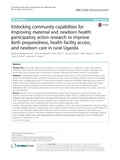Unlocking community capabilities for improving maternal and newborn health: participatory action research to improve birth preparedness, health facility access, and newborn care in rural Uganda
| dc.contributor.author | Ekirapa-Kiracho, Elizabeth | |
| dc.contributor.author | Namazzi, Gertrude | |
| dc.contributor.author | Tetui, Moses | |
| dc.contributor.author | Mutebi, Aloysius | |
| dc.contributor.author | Waiswa, Peter | |
| dc.contributor.author | Oo, Htet | |
| dc.contributor.author | Peters, David H. | |
| dc.contributor.author | George, Asha S. | |
| dc.coverage.spatial | Uganda | en |
| dc.date.accessioned | 2017-04-20T11:51:09Z | |
| dc.date.available | 2017-04-20T11:51:09Z | |
| dc.date.issued | 2016-11-15 | |
| dc.identifier.citation | Ekirapa-Kiracho, E., Namazzi, G., Tetui, M., Mutebi, A., Waiswa, P., Oo, H., Peters, D.H. and George, A.S. (2016) Unlocking community capabilities for improving maternal and newborn health: participatory action research to improve birth preparedness, health facility access, and newborn care in rural Uganda. BMC Health Services Research, 16(7): 638. | en |
| dc.identifier.issn | 1472-6963 | |
| dc.identifier.uri | https://opendocs.ids.ac.uk/opendocs/handle/20.500.12413/12950 | |
| dc.description.abstract | Background: Community capacities and resources must be harnessed to complement supply side initiatives addressing high maternal and neonatal mortality rates in Uganda. This paper reflects on gains, challenges and lessons learnt from working with communities to improve maternal and newborn health in rural Uganda. Methods: A participatory action research project was supported from 2012 to 2015 in three eastern districts. This project involved working with households, saving groups, sub county and district leaders, transporters and village health teams in diagnosing causes of maternal and neonatal mortality and morbidity, developing action plans to address these issues, taking action and learning from action in a cyclical manner. This paper draws from project experience and documentation, as well as thematic analysis of 20 interviews with community and district stakeholders and 12 focus group discussions with women who had recently delivered and men whose wives had recently delivered. Results: Women and men reported increased awareness about birth preparedness, improved newborn care practices and more male involvement in maternal and newborn health. However, additional direct communication strategies were required to reach more men beyond the minority who attended community dialogues and home visits. Saving groups and other saving modalities were strengthened, with money saved used to meet transport costs, purchase other items needed for birth and other routine household needs. However saving groups required significant support to improve income generation, management and trust among members. Linkages between savings groups and transport providers improved women’s access to health facilities at reduced cost. Although village health teams were a key resource for providing information, their efforts were constrained by low levels of education, inadequate financial compensation and transportation challenges. Ensuring that the village health teams and savings groups functioned required regular supervision, review meetings and payment for supervisors to visit. Conclusions: This participatory program, which focused on building the capacity of community stakeholders, was able to improve local awareness of maternal and newborn health practices and instigate local action to improve access to healthcare. Collaborative problem solving among diverse stakeholders, continuous support and a participatory approach that allowed flexibility were essential project characteristics that enabled overcoming of challenges faced. | en |
| dc.language.iso | en | en |
| dc.publisher | BMC Health Services Research | en |
| dc.rights | This article is distributed under the terms of the Creative Commons Attribution 4.0 International License (http://creativecommons.org/licenses/by/4.0/), which permits unrestricted use, distribution, and reproduction in any medium, provided you give appropriate credit to the original author(s) and the source, provide a link to the Creative Commons license, and indicate if changes were made. The Creative Commons Public Domain Dedication waiver (http://creativecommons.org/publicdomain/zero/1.0/) applies to the data made available in this article, unless otherwise stated. | en |
| dc.rights.uri | http://creativecommons.org/licenses/by/4.0/ | en |
| dc.subject | Health | en |
| dc.title | Unlocking community capabilities for improving maternal and newborn health: participatory action research to improve birth preparedness, health facility access, and newborn care in rural Uganda | en |
| dc.type | Article | en |
| dc.rights.holder | © The Author(s). | en |
| dc.identifier.externaluri | https://bmchealthservres.biomedcentral.com/articles/10.1186/s12913-016-1864-x | en |
| dc.identifier.doi | 10.1186/s12913-016-1864-x | |
| dcterms.dateAccepted | 2016-11-15 | |
| rioxxterms.funder | Default funder | en |
| rioxxterms.identifier.project | Default project | en |
| rioxxterms.version | VoR | en |
| rioxxterms.versionofrecord | 10.1186/s12913-016-1864-x | en |
| rioxxterms.funder.project | c941507f-fd0b-4fc3-9822-4b2132f61a1d | en |
Files in this item
This item appears in the following Collection(s)
Except where otherwise noted, this item's license is described as This article is distributed under the terms of the Creative Commons Attribution 4.0
International License (http://creativecommons.org/licenses/by/4.0/), which permits unrestricted use, distribution, and
reproduction in any medium, provided you give appropriate credit to the original author(s) and the source, provide a link to
the Creative Commons license, and indicate if changes were made. The Creative Commons Public Domain Dedication waiver
(http://creativecommons.org/publicdomain/zero/1.0/) applies to the data made available in this article, unless otherwise stated.


